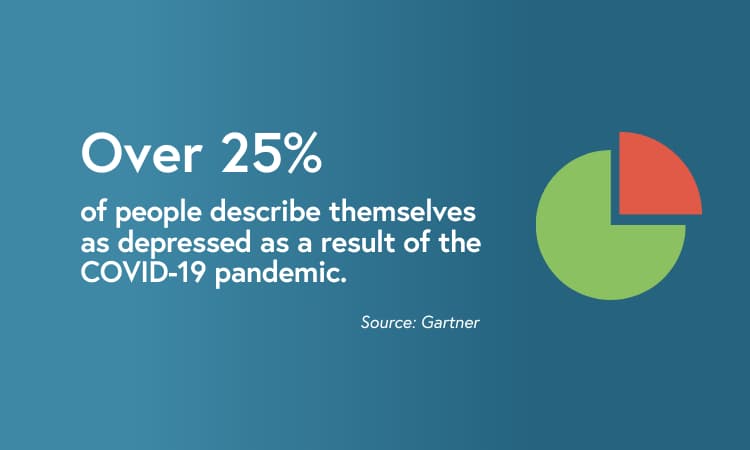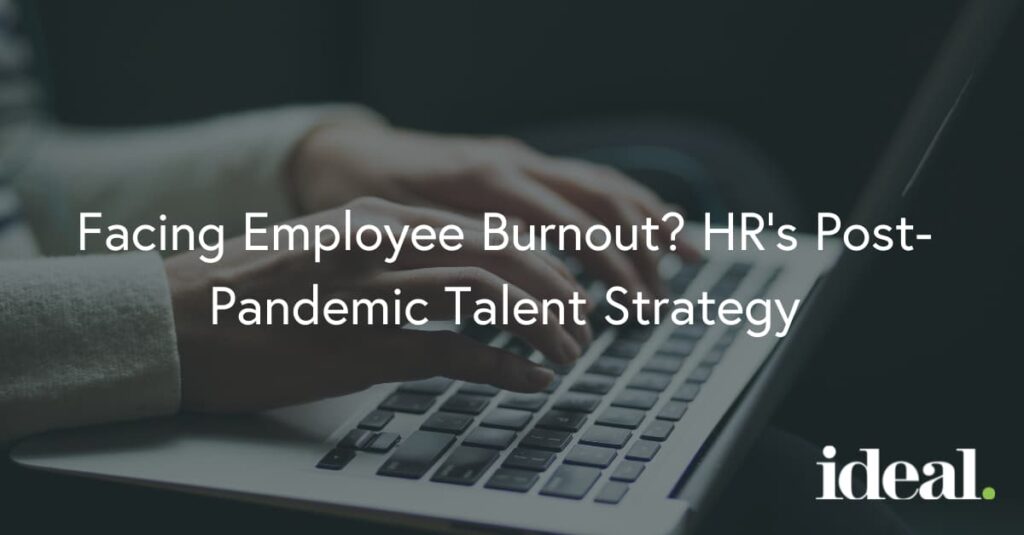
Even Zoom’s CEO has Zoom fatigue. At the Wall Street Journal’s CEO Council Summit in May, Eric Yuan admitted that he also suffers from digital fatigue and doesn’t have back-to-back meetings anymore for a screen break.
For employees working from home, consider how many screens are in their work environment, counting computer screens and their phone. The remote workplace has operated strictly through screens for over a year. With emails, video conferencing, project management systems, and more, workers spend their entire workday interacting through screens.
A troubling trend on the horizon: the post-pandemic workforce turnover is coming. 40% of global workforce members are considering leaving their job post-pandemic, according to a Microsoft survey.
Employee burnout is leading many people to reconsider their current jobs after sheltering in place for over a year. Read on for our top three guidelines that HR can employ to prioritize employee wellbeing and plan for a post-pandemic talent strategy.
A steady wave of COVID-19 burnout
The results are in: across various age groups, industries, and experience levels, remote workers are burnt out. After over a year stuck at home under the unrelenting pressures of Covid-19, the pandemic has taken a toll on people’s stress and anxiety levels. A study conducted by Indeed found generations experiencing burnout include:
- 58% of Gen Z
- 59% of millennials
- 54% of Gen-X, a 14% increase from pre-pandemic levels
- 31% of Baby Boomers
Of all survey respondents, 80% believe Covid-19 has worsened workplace burnout, with a lack of work-life balance and fear of job loss.
Burnout is an organizational problem, and now a diagnosable syndrome according to the World Health Organization. WHO described as “a syndrome conceptualized as resulting from chronic workplace stress that has not been successfully managed.”
Employers can’t afford to ignore employee burnout. For many organizations, the future of the office remains a question mark, with the hybrid remote work model remaining a popular choice. For employees who feel they’re “living at work”, this digital fatigue continues to impact overall morale.
A Gartner survey finds more than one-quarter of the workforce describes itself as depressed as a result of the COVID-19 pandemic.

Why this matters to HR leaders
The results of Gartner’s HR survey show how strongly employees need stress management and employee well-being support. Consider the diverse range of employee needs in your organization, across different demographics and groups of people.
Many organizations may be setting their sights on economic recovery, but it’s just as important to look at employee retention with clear eyes. Many people are looking for a change, including better compensation, less stress, and a better work/life balance. Hiring is a time-consuming process for Human Resources, but it also impacts departments trying to rebuild their team and move ahead with larger organizational goals and projects.
So how can HR leaders better support their people?

How COVID-19 has drastically changed traditional office expectations
Envoy also released a Return to the Workplace Report in which 41% of employees would be willing to take a job with a slightly lower salary if it offered a hybrid working model, with work from home flexibility.
The pandemic has made clear that the majority of employees don’t see themselves returning to work in the same capacity. Some employees have enjoyed the lack of commute and productivity of working from home while others have felt isolated from their team. When asked about their feelings around offices reopening or continuing to work remotely, the most popular answer is the hybrid model.
The primary anxiety for employees is having the choice made for them. Flexibility is key for easing employee concerns around the return to the office and your organization’s reopening plans.
Develop policies and processes for supporting employee mental health
The effects of COVID-19 and the mental health pandemic could continue to impact your people for many years. Take the time now to plan for the well-being of your employees for the future.
- Make the time to talk. Encourage empathy and let your team know that they can feel comfortable disclosing that they need help with mental or emotional issues.
- Empower employees to take action on their own. Share all of the benefits and resources that are available to them.
- Make reasonable accommodations on an individual basis. Let your employees know this information is always kept confidential.
HR leaders can strategically redesign their benefits process to account for inequities. For example, working caregivers can benefit from additional PTO programs for childcare and eldercare needs. Consider how language can be a barrier and expand telehealth offerings to include multiple languages.
Make wellbeing a priority and even schedule it into the calendar. Ceridian recently designated April 16th as Wellness Day to give employees a day off without emails, video calls, or meetings.
Ideal, aligned with Ceridian’s focus on mental wellbeing, also scheduled a ME Day for employees on May 7th, a day to recharge, relax with family, or work without distraction. The first ME Day was also in response to digital fatigue back in May 2020, as a reprieve from two months of working from home.
Optimize your rehiring process
People come and go from organizations but the increased pressure of high turnover rates and burnout will challenge organizations to keep pace with their competitors. As the economy rebounds, time-to-fill will be crucial for reducing gaps in your workforce as work ramps up.
Don’t wait until the last moment to think about hiring plans. Transform your recruiting team’s efficiency and productivity by reducing their manual task load. AI recruitment solutions integrate directly with your team’s existing workflows and can alleviate daily manual tasks, such as:
Automating workflows. Reduce the manual task load on HR’s plate with automation tools to put the focus back on strategic initiatives and employee interaction. AI-based tools automatically progress candidates through existing workflows in the ATS.
Automated workflows can save recruiters on average 4 hours per day.
Trigger assessments, documents, and calendar invites. Create a customized candidate experience, without putting a list of reminders on your team’s plate. Improving the candidate experience doesn’t mean adding random incentives when what the candidate really wants is regular touchpoints and updates on their application status.
Intelligent resume screening. 46% of hiring managers say identifying the right candidate is the biggest obstacle in hiring, according to research by LinkedIn.
Screen thousands of applications automatically for a shortlist of your ideal candidates. Your recruiter’s time can be better spent in face-to-face interviews with qualified candidates and other higher-value tasks that require creativity, empathy, and person-to-person communication.
After the challenges of the past year, employee needs and working styles may have shifted drastically. Focusing on mental health and preventing employee burnout will be key factors in retaining your workforce for the long term.
